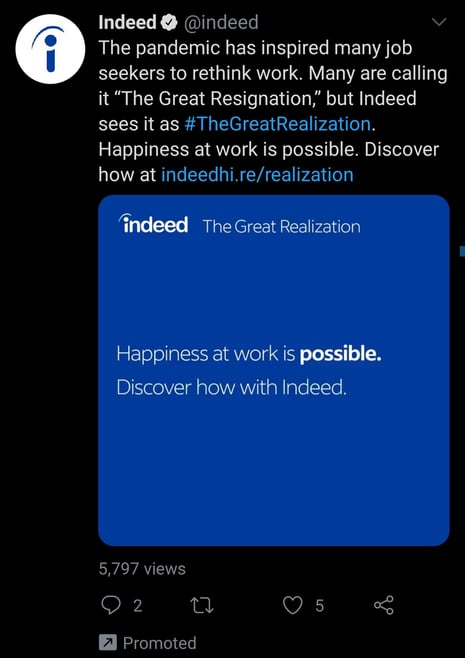Social media isn’t just for brand awareness. It’s also a vital part of ecommerce. An online store may be enough for your industry, but social selling offers opportunities for growth by making purchasing your products as easy as possible for a whole new world of potential customers. With social selling, your business can say goodbye to cold calling and sales demos and say hello to new customers who didn’t know they needed what you’re selling.
What Is Social Selling?
Social selling is uploading and selling products directly on a social media platform. That way, when customers see the post and want to make a purchase, they don’t have to go to the website. Facebook, Instagram, Pinterest, and even LinkedIn have features that allow users to directly sell products and services on their platforms.
And we’re not talking about DMing your high school classmates about that “exciting business opportunity.”
With these features, you can reach a real audience and make it easy for them to share their purchases with others.
How Social Selling Can Grow Your Business
You may be asking yourself “cool but how does selling stuff on Instagram help my business?” Let’s count the ways:
More Potential Customers
According to Forbes, 4.2 billion people worldwide are active on social media and these networks are still growing. In fact, social media platforms gained 490 million users in 2020 alone, which is a 13.2% increase.
That’s a lot of people with the opportunity to learn about your business. When they can shop right from the sites they’re spending time on every day, it’s more convenient than going to a brick and mortar store or even going to a website.
More Revenue
Naturally, that bigger audience pool means more sales and more cash money.
Increased Visibility & Awareness
You may not get sales right away, but sales posts can still drive brand awareness. Then that awareness can lead to purchases and even becoming a promoter of your products since social media encourages sharing content to your networks.
More Engagement
Social media allows you to establish a relationship with your customers and get feedback so you can improve your customer experience.
Social Selling Works
According to LinkedIn:
- Businesses that are leaders in the social selling space create 45% more sales opportunities than brands with a low social selling index.
- Businesses that prioritize social selling are 51% more likely to reach their sales quotas.
- 78% of businesses that use social selling outsell businesses that don’t use social media.
What is the Social Selling Index?
The Social Selling Index is a metric created by LinkedIn to measure the success of a company’s social selling endeavors using the four elements of social selling:
- Establish Your Professional Brand: score is based on completion of your profile and the quality of content you post.
- Find the Right People: score is based on use of sales navigator
- Engage with Insights: score is based oh sharing popular content
- Build Relationships: based on how often and how successfully you reach out to people.
Each element is worth 25 points, leading to a highest possible overall score of 100 points. Even if LinkedIn isn’t the primary place you sell, your score can still help you find areas where your social selling strategy can improve and compare yourself to your competitors and other people in your network.
Choosing the Right Platform for Selling on Social Media
It’s better to pick two or three platforms and use them well than to try to sell your products on all of the social media channels. Which platforms work for you will depend on your industry, your target audience, and your social media marketing budget. Here are the basics of selling products and services on the major social platforms.
Since Facebook is known for its effective advertising algorithm, it comes as no surprise that it’s also an effective, popular choice for social selling. 18.3% of American Facebook users made a purchase via Facebook in 2020.
Here are a few of Facebook’s selling features and tips to make the most out of them:
Product Catalog
The Facebook product catalog allows you to link your ecommerce inventory to your business page and sell those products directly on Facebook. The inventory stays up to date because the product catalog lets Facebook and your online store communicate with each other.
Facebook Advertising
You can also link your inventory directly to Facebook ads and highly target new potential customers. When you create an ad you can create
- Core audiences based on a user’s age, gender, interests, geography and other demographics
- Custom audiences to target those who’ve already engaged with your business, online or offline
- Lookalike audiences so you can reach new people whose interests are similar or overlap with your best customers.
All ads must be connected to a Facebook page for the business and include a call to action.
This is what the first page of creating an audience looks like:
.png?width=454&name=Social%20Selling%20FB%20Audience%20(1).png)
Here are some more categories you can target:
.png?width=1226&name=Social%20Selling%20FB%20Detailed%20Targeting%20(1).png)
Facebook Marketplace
Facebook Marketplace is like an online garage sale. For some businesses it’s a viable option to build a customer base early on in your social sales journey. The marketplace is a good fit for selling homemade goods locally, thrift shops with changing inventory, and promoting sales to local customers.
An example of a Facebook Marketplace post from an online store:
.png?width=1600&name=Social%20Selling%20FB%20Marketplace%20(1).png)
Best Industries for Facebook
- Clothing & Apparel
- Consumer packaged goods
- Gift products
- Home furnishings
- Beauty products
- Fitness companies
Put a Frequency Cap on Ads
There’s a fine line between promoting often and making users feel harassed by ads. Putting a frequency cap on your ads can help you stay on the right side of that line.
Personalize Your Promotions
Facebook famously allows advertisers to target users very specifically. Take advantage of that by promoting products that are tailored to your target audience.
As a 100% visual platform, Instagram is a great place to show off your products to its 1 billion users. It’s not quite the advertising giant that Facebook is, but it’s catching up. 200 million Instagram users visit a profile at least once a day and 81% of Instagram users are researching products and services on the platform. Here’s how you can take advantage of what Instagram has to offer for sellers.
Shoppable Posts
Shoppable posts are the Instagram equivalent of Facebook’s product catalog, but the user experience is different. They are posts that are linked to your online store inventory. When a user taps on a shoppable post, they will see the name and price of the item. If they want more information, they can tap the post a second time and make the purchase directly on the app.
Every Sale Post on Instagram Should Include:
- A high-quality image of the product from your post
- The products description
- The cost of the product
- A link that takes the user directly to your website, where they can purchase your product
- Keywords as hashtags to help more people see your posts
An example of an Instagram Shoppable Post:
.jpeg?width=525&name=Social%20Selling%20IG%20(1).jpeg)
Best Industries for Instagram
- Clothing & Apparel
- Consumer packaged goods
- Gift products
- Home furnishings
- Beauty products
- Fitness companies
Sell a Lifestyle
Instagram is a visual platform full of glamorous models and influencers. Your sales posts should convince users that purchasing your product will make their lives better by showing photos of pretty people using it.
Pinterest isn’t just for recipes and fantasizing about weddings. Businesses can also use it to sell products directly to Pinterest users now. Take advantage of this underrated platform if your business is right for it.
Buyable Pins
You can create buyable pins, which are basically what Pinterest calls their ads, by connecting your ecommerce platform to your account. Pinterest links to Shopify, Magento, BigCommerce, and other popular ecommerce platforms.
Buyable pins are easy to manage. Whenever you add a new product, just log in to your Pinterest account after the product goes live and it will automatically become a buyable pin.
An example of a buyable pin:
.png?width=564&name=Social%20Selling%20Pinterest%20(1).png)
Best Industries for Pinterest
- Home Decor or Renovations
- Gardening or Landscaping
- Clothing
- Makeup
- Arts and Crafts
- Travel
- Food and Drink
- Health and Self-Improvement
Keep Demographics in Mind
Women make up 60% of Pinterest’s user base, making it more gendered than the typical social network. It is also most popular with users under 30.
Remember That Pins Don’t Disappear
On most other social platforms, posts get buried and ads disappear. However, Pinterest works differently. Since most pins are repins from other users, a pin from years ago could still circulate.
Target By Keywords
Pinterest users often find pins by searching for topics. You can help them find your shoppable pins by tagging them with relevant, popular keywords.
Twitter isn’t exactly as known for selling products as Facebook or Instagram, but it’s still a great option if your business has a sizable Twitter audience.
Ads and Promoted Tweets
There are two types of ads that Twitter users can see in their feeds: Twitter Ads and Promoted Tweets. Twitter ads can set up campaigns to:
- Increase your follower count
- Drive website clicks and conversions
- Collect contact information
- Promote a sale or promotion
Promoted Tweets are tweets that you can pay to appear on the feeds of targeted users. They typically include either direct links to product pages or landing pages. Both can be effective ways to sell your products to the Twitter-sphere.
An example of a promoted tweet:

Affiliate Marketing
Twitter is also a great place for affiliate marketing. Since Twitter’s model encourages retweets and engagements, it’s well-suited for starting conversations with others in your niche around the world.
Social Listening on Twitter
Twitter is useful for monitoring the online reputation of your business because users can make lists to keep track of what people are saying about your business without following them. Creating lists of the following categories is a good place to start your social listening.
- Existing customers
- Prospects
- Competitors
Use Relevant Hashtags
Creating hashtags for your business is a great way for users to see all of your tweets about topics in one place. Using them for a Twitter Chat allows your customers to engage with your company and give feedback.
Get Verified if You Qualify
The verified badge signifies “yes, it’s really me” for people and businesses that are at risk of impersonator accounts or similar usernames. Entities in “music, acting, fashion, government, politics, religion, journalism, media, sports, business, and other key interest areas” are eligible for verification.
Use Twitter Moments
Twitter moments are collections of timely tweets about a topic or event. Twitter groups moments into the categories Today, News, Entertainment, and Fun. You can create your own Moments section on your profile to take advantage of timely trends.
LinkedIn isn’t just for applying for jobs and networking. It’s also an underrated platform for advertising and sales, especially for B2B buyers. As a matter of fact, 96% of B2B content marketers use LinkedIn for organic marketing. Facebook is the next most popular platform, used by 82% of B2B content marketers. It may not be right for every business, but here are some tips to take advantage.
An example of a LinkedIn ad:
.png?width=538&name=Social%20Selling%20LinkedIn%20(1).png)
Build Your Credibility
- Only share information and content from credible sources.
- Highlight your expertise relevant to potential buyers on your LinkedIn profile.
- Ask for endorsements and recommendations from your contacts
Extend Your Network
- Join LinkedIn groups relevant to your industry
- Seek out mutual connections with existing contacts using the search feature
- Connect with potential customers
- Get notifications when prospects join LinkedIn
Use the Sales Navigator
- Target the right prospects
- Use analytics to understand and improve your performance
Snapchat
You may not necessarily think of Snapchat for sales and marketing purposes, but its purely social interface makes it easy to create ads that don’t look like ads. It’s also a good tool to include in your digital marketing strategy if you want to appeal to younger consumers.
Snapchat does not have an equivalent of a product catalog or shoppable posts, but they do have ads that can include links and calls to action. Snapchat ads should be short, creative video content.
Example of a Snapchat Ad:

Best Industries for Snapchat
- Retail apparel stores
- Restaurants
- Events
- Tech gadgets
- Travel companies
Social Selling Best Practices
Here are some general practices that will make you a better social salesperson no matter which platforms you use.
Establish Your Brand
Going right into sales and focusing the entirety of your social media presence on promotions can turn people off. Especially if they’re not familiar with your brand. The best way to establish your brand on social networks is by posting interesting, shareable, relevant content and sharing the same from thought leaders in your industry.
Build Relationships
Social networks are all about making connections. Listen to what your audience is saying about your business and course correct according to pain points. Respond to customer comments when appropriate to show that you care about their feedback. Social lists and Hootsuite Streams can help you track this feedback across channels.
Keep it Real
Personalize your messaging to leads so you can start genuine conversations and hope it will lead to clients.
- Acknowledge your mutual professional contacts.
- Refer to a piece of content you both shared or reacted to.
- Highlight a shared interest or something else you have in common
Be Patient
You shouldn't be discouraged if you aren't getting sales right away. Building a good reputation and fostering relationships over social media takes time. Don’t be afraid to follow up with new leads.
How Sav Can Help Sell on Socials
Sav is committed to helping small business owners succeed online from purchasing a domain to selling products and services.
All Sav users can:
- Sell products on Facebook and Instagram
- Share products on social media
- Track inventory and get low stock notifications
You can even start selling today!
Newsletter
Popular
Top Articles
Recommended articles
How to Come up With Ecommerce Product Ideas
Whether you’re starting a new ecommerce business or expanding a pre-existing one, what products to sell online is an important decision....
Read moreThe 10 Best Providers for Print on Demand Books
Always wanted to write your own book? Self-publishing with a print on demand book service can make that dream a reality more easily than...
Read moreHow to Start an Online Store
Launching a successful online store or ecommerce website is easier than ever. Follow this step by step guide to start your ecommerce...
Read more



